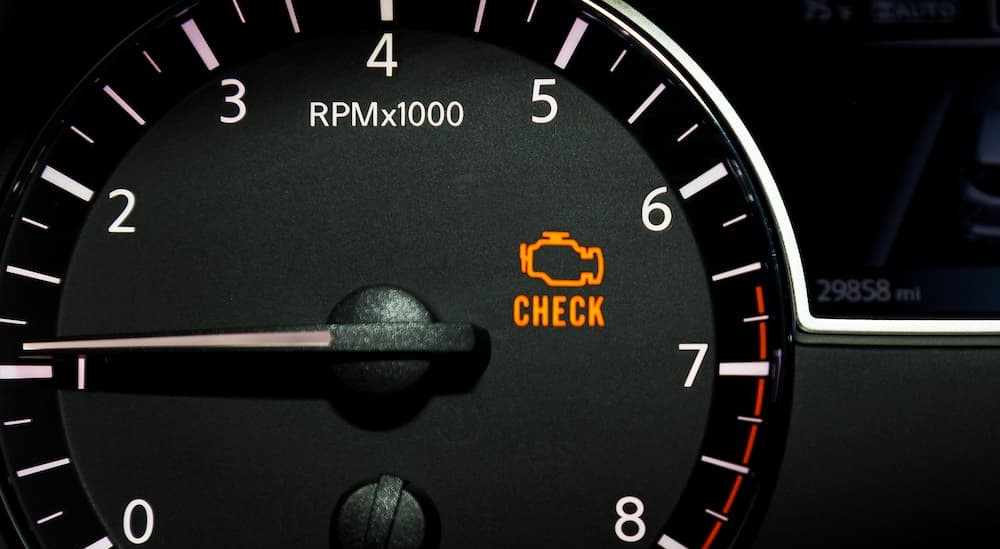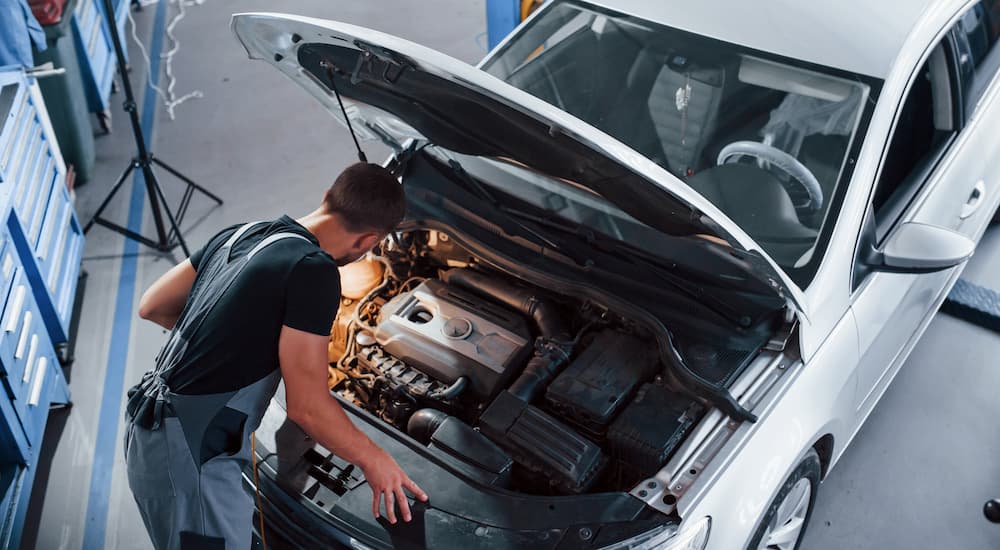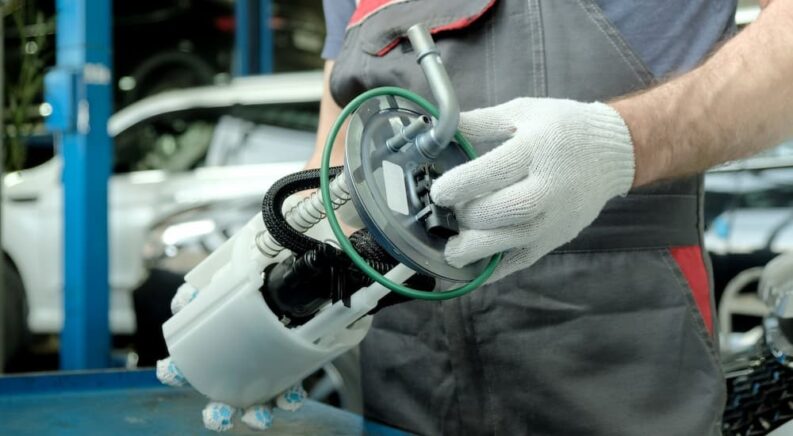When it comes to some common vehicle components, the name isn’t always very descriptive (I’m looking at you: catalytic converter) but that’s certainly not the case when it comes to fuel pumps. As the name implies, fuel pumps are small pumps powered by electric motors that move gas from the fuel tank to the engine. The fuel pump, along with the fuel level sensor and fuel filter, ensure that you’re always getting a steady flow of gas every time you step on the accelerator. The fuel flows from the tank to the fuel injectors before being sprayed into the engine’s cylinder and mixed with air, where it’s ignited by the spark plugs.
The exact design and location might differ depending on the age, make, and model of the vehicle, but in most modern vehicles, it can be found inside the fuel tank itself. Once upon a time, vehicles used mechanical fuel pumps located near the engine to get the job done, but the fuel injection systems found on most of today’s vehicles require higher pressure, making electric fuel pumps a more viable option. Aside from offering increased pressure, electric fuel pumps are also less prone to accidental combustion as they’re submerged in gasoline instead of nestled next to a high-temperature engine. This also reduces the noise created by the pump, as it is largely muffled by the surrounding gas. This design is clever from an engineering perspective, but it does have its downsides. Primarily, its hard-to-reach location can make it difficult to know when something has gone wrong, leading many to incorrectly diagnose fuel pump-related issues as other types of automotive maladies. So what signs should you keep an eye out for if you suspect a faulty fuel pump? Let’s look at some of the biggest red flags in this guide to bad fuel pump symptoms.

How Long Does It Last?
Fuel pumps are one of the more rugged components in a vehicle, and are typically rated to last at least 100,000 miles. It’s not unusual to see a fuel pump that’s reached the 200,000-mile mark and kept on chugging, but it all depends on factors that are largely out of a driver’s control. Fuel contamination is one of the leading causes of fuel pump failure, with corrosion, debris, and moisture all wreaking havoc on the component.
When these contaminants start to build up, they can put a strain on the fuel pump’s filters, resulting in blockages that can interrupt the flow and lead to decreased acceleration. Electrical issues are another common cause of fuel pump failure, with rusted, loose, or even melted connectors and wiring taking their toll on fuel pump performance. While these electrical problems can appear randomly, you can reduce the likelihood of such issues by not running your vehicle on a low tank of gas, which can overheat the fuel pump’s electric motor.
Given how difficult and time-consuming it can be to reach the fuel pump, some experts recommend doing a little preemptive maintenance. If you’re dealing with a repair to another part of the fuel system that’s located near the fuel pump, and your odometer has already hit the 100,000-mile mark, it might not be a bad idea to replace the fuel pump while you’re in the neighborhood. It’ll save you a king’s ransom in labor costs and should give you another 100,000 miles of worry-free driving, at least as far as the fuel pump is concerned. So how’s a driver to know when their fuel pump is ready to call it quits? If you suspect your vehicle’s fuel pump might be on its last legs, then keep your eye out for some of the following.
Signs & Symptoms – Noise
A distinctive whining noise is usually one of the first signs that your fuel pump might be on the way out. A well-functioning fuel pump should only make a subtle humming noise, if it makes any noise at all, so if you start hearing a sound emanating from the fuel tank, take notice. This whining noise is usually loud enough to be heard when standing outside of the vehicle itself, but it’s not always entirely indicative of a bad fuel pump. If your vehicle is very low on gas, you might hear a similar sound, so make sure to check your fuel gauge before you book an appointment with your mechanic or dealership.
Signs & Symptoms – Starting Trouble
It doesn’t take an automotive engineer to know that gas-powered vehicles work best when they’re fed a steady supply of gas. If your fuel pump is on the fritz, the engine will often let you know about it in a hurry with long, difficult starts, or by failing to start at all. Of course, there are lots of common automotive issues that could be the reason your car won’t start, from a dead battery or broken distributor cap to a worn ignition coil or bad timing belt, but if you’ve noticed any other tell-tale signs of a faulty fuel pump, you might have your culprit.
Signs & Symptoms – Stalling
Failing to get your car started is one thing, but having it stall out in the middle of a ride can be a downright scary experience. To make matters worse, these stalls often happen at high speeds as the vehicle struggles to deliver enough fuel to the engine to meet your power requirements. The sputtering issues might be barely noticeable when it first starts, manifesting as nothing more than a slight hiccup in your normal internal combustion cycle, but over time it can grow into a bigger, more expensive problem that requires mechanical intervention. If your vehicle starts stalling and sputtering while driving at high speeds but performs a little more consistently when you let off the gas, the fuel pump should be your number-one suspect.

Signs & Symptoms – Overheated Engine
Your engine temperature gauge is a useful way to diagnose some common automotive problems, and should always be taken seriously if it starts to creep into the danger zone. An overheated engine can cause some of the biggest and most expensive problems a driver can face, with the worst-case scenario being a full engine replacement. Running your vehicle with a bad fuel pump can easily cause the engine to overheat as it will not provide the engine with enough gas, causing it to run hot and possibly even stall while you’re driving. If your engine dies in the middle of a ride, starts right back up, and then performs the whole routine over again a half-hour later, chances are you’re looking at a faulty fuel pump.
Signs & Symptoms – Inconsistent Power
Does your vehicle struggle with steep roads, or start to drag when loaded down with cargo? Both these scenarios require more gas than normal driving, so if your car engine starts to struggle at these crucial moments, the fuel pump could be the reason. Alternatively, a bad fuel pump can also cause unexpected surges in power as the pump overloads the engine with gas. If you’re starting to feel like you don’t know what your engine is going to do from one moment to the next, or a sudden loss of power becomes “normal,” then the fuel pump could be the cause.
Signs & Symptoms – Reduced Fuel Economy
Gas prices are high enough without wasting fuel on a bad pump, which is why it’s always a good idea to keep track of your average gas mileage. When a fuel pump is on its way out, it could start to have trouble regulating how much fuel is sent to the engine resulting in wasted gas as the vehicle burns through excess fuel. This might seem a bit odd as you’d normally expect a failing pump to deliver less fuel to the engine not more, but there’s a simple explanation. Most fuel pumps are built with a relief valve that can deliver additional fuel to the engine if it senses that the current flow is inadequate. This relief valve can flood the engine with extra fuel, which will fly right out of your tailpipe in the form of black exhaust smoke. Being able to correctly diagnose a faulty fuel pump is just one of the reasons why it’s so important to keep track of your vehicle’s fuel economy.
Diagnosing a Failing Fuel Pump
While there are plenty of signs to keep an eye out for if you suspect a bad fuel pump, these symptoms aren’t necessarily that unique. As I mentioned before, there are a number of other issues that can masquerade as a faulty fuel pump, which is why it’s so important to get the problem diagnosed by a qualified mechanic. That said, there are a few simple at-home tests you can perform to help narrow it down, saving you valuable time and labor costs that would otherwise be spent at the auto shop.
First off, inspect the fuse on your fuel pump relay. If it’s blown and in need of replacement, that often signals a power-hungry fuel pump that’s not long for this world. If it burns out again shortly after being replaced, it’s a sure sign that something is amiss in your gas tank. You can also perform a fuel pressure test to help diagnose the issue, using a fuel pressure test gauge to ensure the pressure is up to the manufacturer’s specifications. If it falls well below the number found in your owner’s manual, it’s probably time to start shopping around for a new fuel pump.
Take Care of Your Fuel Pump, and It Will Take Care of You
From whining and overheating to stalling and rough starts, there are plenty of ways to spot a damaged fuel pump; it’s just a matter of knowing what to look for since a bad fuel pump might not always manifest as a full-on failure. Decreased engine performance, reduced fuel economy, and inconsistent power are just a few of the downsides of running a vehicle with a faulty fuel pump, which is why the issue should be addressed well before it spirals into an expensive repair that affects other vital components. With an average repair cost of between $900 and $1,200, replacing a fuel pump is no small investment, which is why you don’t want to waste a lot of time and money pinpointing the problem. Now that you have a sense of what to watch for, however, it should be easier to quickly and efficiently identify fuel pump-related issues.

